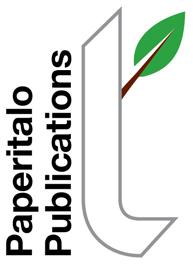 Capital Argument$
A trademark of Paperitalo Publications
|
|
|
Published on the 15th of every month
|
|
|
|
|
|
|
|
Capital Arguments presents Engineering Manager of the Year Award
Mac Switkowski of Pratt Industries was presented the Capital Arguments Engineering Manager of the Year Award late last month at a banquet in Atlanta attended by nearly fifty industry professionals. Switkowski was honored for being the lead engineer of Pratt Industries' new $260 million recycled paper mill that has begun production in Valparaiso, Indiana. Paperitalo Publications presents the award only to individuals who have managed extraordinary projects. The project's extraordinary features can be schedule, technology, cost, or all three.
Despite a complete change of paper machine suppliers mid-project, the startup schedule and budget were met on the Valparaiso Project. Paperitalo Publications established the award in 2008, and it has been presented only four times since then. The award is meant to honor people and companies that have demonstrated a philosophy that makes extraordinary projects possible, and can be completed safely and responsibly, with lower capital costs and downtime avoidance. Anthony Pratt, chairman and CEO of Pratt Industries said, via video, that Switkowski has been a big part of the company's success over the years. He added, "He's been a key member of the Pratt team from the very beginning, right back to when we built our first paper mill in America in Hartford City, Indiana, back in 1988. For more than a quarter of a century, he has taken increasingly greater roles in our subsequent paper mills in Conyers, Georgia; Staten Island, New York; Shreveport, Louisiana; and Valparaiso, Indiana. And at every stop along the way, he has not only demonstrated his superb skills, but also his fantastic spirit and can-do attitude. Congratulations, Mac; well done." Switkowski said he was deeply honored to be receiving the award, but quickly added that he considers it a company accolade. He continued, "This award is for an individual, but the reality is that when you work with others, it's not just one person's award, it's for all of us."
And Paperitalo Publications adds its congratulations along with the award to Mac for a job exceedingly well done.
|
| |
Mac Switkowski, center, holds up his Capital Arguments Engineering Manager of the Year Award that was presented by Paperitalo CEO Jim Thompson, left, as Luis Henao, right, manager at Pratt Industries applauds.
|
________
The Trial of a Capital Improvement Dispute with a Third Party Contractor or Designer
by Scott Witzigreuter, Attorney
Usually, capital disputes before triers of fact (a judge or a jury),
 |
|  |
Scott Witzigreuter's civil litigation practice focuses on construction litigation and commercial contract litigation. He is a partner at the law firm Weinberg, Wheeler, Hudgins, Gunn & Dial.
|
in which evidence is presented in the form of documents and witness testimony, arise in the arbitration context. "Trials" in a court of law and before a judge or jury involving capital disputes are rare. In an arbitration, the parties present their evidence to one or more individuals already well educated in the arena of capital disputes. (At least the arbitrators should be well educated; if not, the parties have picked the wrong arbitrators). In addition, the rules of evidence are less restrictive than in a court environment. Neither of these arbitration maxims is true in a courtroom setting, however, which requires the attorneys, their clients and the experts to extricate themselves from an arbitration mindset and make some fundamental changes in their approach to a trial.
First, and probably most obvious, the trial presentation should take into consideration the relative lack of knowledge and experience of the triers of fact. Whether a jury or a judge, it is likely that the party hearing the arguments and evidence will have no prior experience in the capital improvement industry, and definitely not with capital improvement claim methodologies and defenses. These potential triers of fact will know nothing of the bid process, estimate development, project delivery methods, the roles of the various parties to a capital improvement project, anticipated productivity and realized productivity and project scheduling. As a result, the plaintiff usually bears a heavy burden in educating the jury about not only the facts that give rise to its claim, but the typical development, pricing and progression of a capital improvement project.
For example, a jury may understand what a "bid" is only in the most general of terms. While in an arbitration a claimant may need only to provide the arbitrators with the bid amount and the logic used to generate the bid, a capital claim plaintiff needs to explain what a bid is, what it is used for, the process of generating a bid, the risks associated with poor bids, the historical bidding process of the plaintiff, an explanation of applied productivity rates, and finally the bid amount. To be blunt, a plaintiff in a capital trial must assume a zero knowledge base and anticipate every piece of information that the trier of fact might need when evaluating a claim based on a bid or refuting a bid-based defense. Obviously, this approach results in greater consumption of time and energy and, frankly, can bore the trier of fact to tears. The alternative, however, is a confused trier of fact, judge or jury, that cannot understand the capital improvement process, much less a capital improvement claim or defense.
Second, and what should be equally as obvious but often times is overlooked, the attorneys participating in a capital improvement trial must know the rules of evidence. The proliferation of arbitrations, while generally a positive development, has led to the unintended consequence of blunting attorneys' skills in introducing evidence via the more formal requirements of a trial. This manifests itself primarily in the introduction of documentary evidence. In order to introduce a document at trial, a proper foundation for the document must be laid and the document must be authenticated, usually by the author or recipient of the document, but also via a corporate representative or records custodian as part of the business record exception. This can be onerous and overlooked because these levels of formalities typically are not required in arbitration. Again, the stricter rules of evidence of a capital improvement trial often result in a more lengthy process that requires calling additional witnesses simply to authenticate documents that the parties likely would call if the dispute was being adjudicated by arbitrators.
In addition to the introduction of documents, attorneys need to be mindful of the more restrictive nature of witness testimony. In an arbitration, attorneys and their witnesses generally enjoy freer rein in presenting their testimony; the testimony tends to be more narrative with fewer questions and when questions are asked, they tend to be more leading than should be allowed under most evidentiary standards. During a trial, direct witness testimony (as opposed to cross examination) becomes more difficult to conduct and requires greater preparation time, i.e. more "rehearsal." On the flip side, opposing counsel must challenge direct testimony and questions on evidentiary objections more often than he or she might in an arbitration. Again, while this might seem obvious, a capital improvement trial requires attorneys to sharpen their evidentiary skills and divest themselves of the arbitration mindset.
_______
Engineering Manager of the Year, call for nominations
We are looking for an individual who has done an extraordinary project, one that almost defies belief. Its extraordinary features can be schedule, technology, cost or all three.
We have often gotten nominees that go something like this, "I nominate Joe because he has done a great job of running our engineering department for the last fifteen years." Quite frankly, we are not interested in such nominees.
However, if you know someone who has led a very exceptional project in the recent past (the last two or three years), we want to know about it. We want to honor them and hold them up as an example for Engineering Managers in every pulp and paper mill around the world.
Just send your nomination, with as much details as you can provide, to jthompson@taii.com. We will seriously consider it.
|
________
Current Patent Activity is available here.
|
|
________
Capital Arguments Engineering Manager of the Year
Hall of Fame
 Since its inception, Capital Arguments has believed extraordinary projects are possible. They can be done safely, responsibly and offer a great advantage to their mills with lower capital costs and saved downtime. We established this award in 2008 to recognize those people and companies that follow this philosophy. This award is given once per year somewhere in the world. We honor our inductees permanently here. Since its inception, Capital Arguments has believed extraordinary projects are possible. They can be done safely, responsibly and offer a great advantage to their mills with lower capital costs and saved downtime. We established this award in 2008 to recognize those people and companies that follow this philosophy. This award is given once per year somewhere in the world. We honor our inductees permanently here.________ Engineering Manager of the Year 2015
Mac Switkowski of Pratt Industries (see article above) ________
Not Awarded 2014
You have to be really good to get this award. We did not receive any qualifying nominations in 2014.
________ Not Awarded 2013
You have to be really good to get this award. We did not receive any qualifying nominations in 2013.________ Not Awarded 2012
You have to be really good to get this award. We did not receive any qualifying nominations in 2012.
________
Ed Kersey--Engineering Manager of the Year 2011
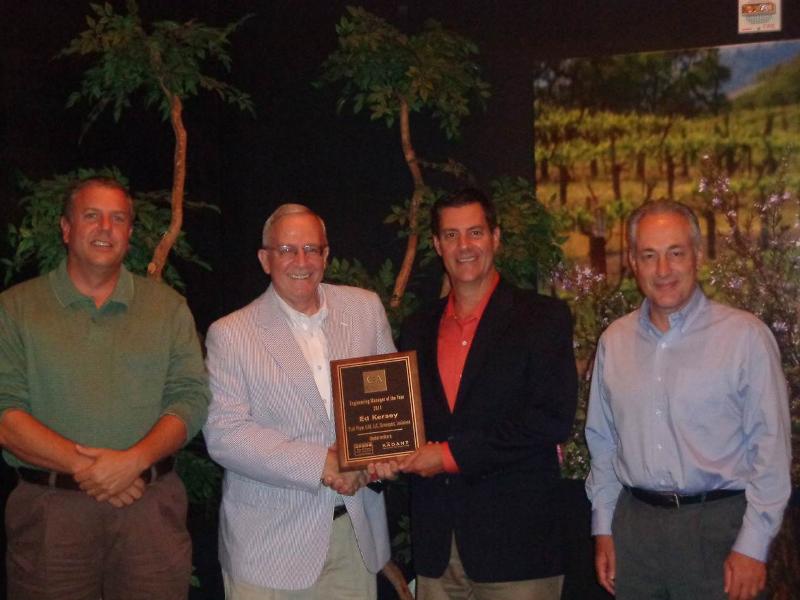
Jim presents Ed with the Engineering Manager of the Year for 2011. (L - R) Matt Nilsen, Jim Thompson, Ed Kersey and Wayne South. Nilsen is Account Manager and South is Business Development Manager for Kadant Black Clawson, underwriter of this year's award. Ed Managed the construction of the Pratt Industries mill in Shreveport, Louisiana which took 13 months from piling to paper on the reel. His reward? They made him mill manager!
Kadant Black Clawson was a major sponsor of the 2011 Award. Here, on the left, Peter Flynn, President of Kadant Black Clawson, receives the company's duplicate of Ed's Award from Steve Roush, Publisher and Editor, Paperitalo Publications.
________
Not Awarded 2010
You have to be really good to get this award. We did not receive any qualifying nominations in 2010.
________
Dean Abrams--Engineering Manager of the Year 2009
Now retired, Dean was an engineer at Corrugated Services, Forney, Texas, USA in the summer of 2009 when he completed his award winning project. Dean managed a team that installed a secondary headbox in 11 hours, 30 minutes, paper-to-paper. The experts had said it would take at least 3 days. In April 2010, we presented the award to Dean in the presence of a number of his colleagues.
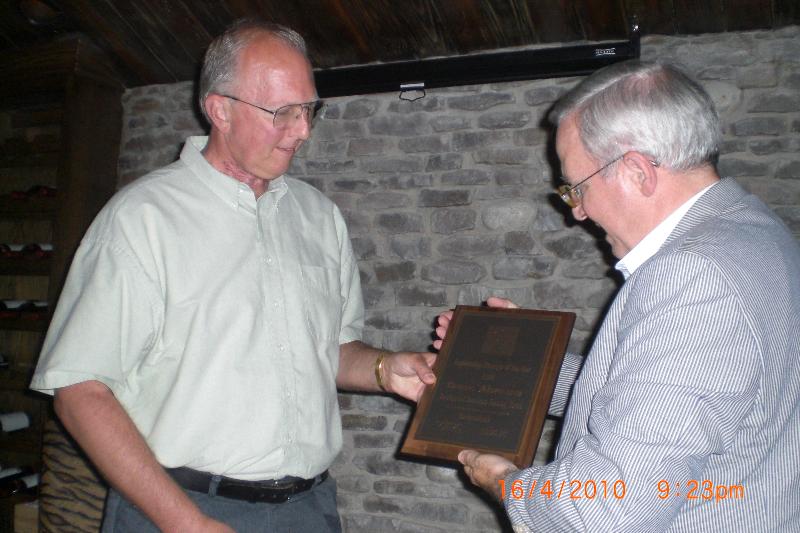 Here is the award we presented to Dean:
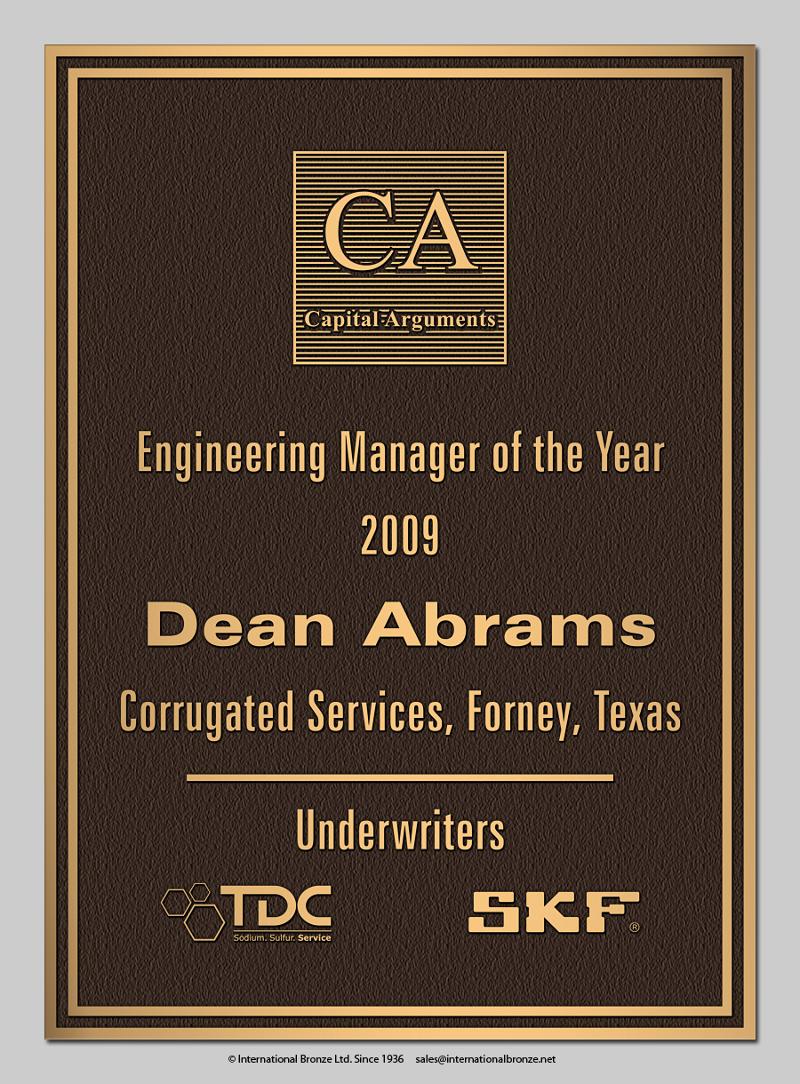
Mike Ahcan--Engineering Manager of the Year 2008
Mike works at the UPM Blandin Mill in Grand Rapids, Minnesota, USA. In 2008, the mill's sole effluent pipe, running outside a building, almost in the Mississippi River, was determined to be in a state of imminent collapse. The experts said it would take a week of total mill downtime to replace it. Additionally, there was a danger of leakage into the river. Mike and his team went to work and replaced the pipe without any downtime and with no spillage. We had a banquet in Grand Rapids for him in July 2009.
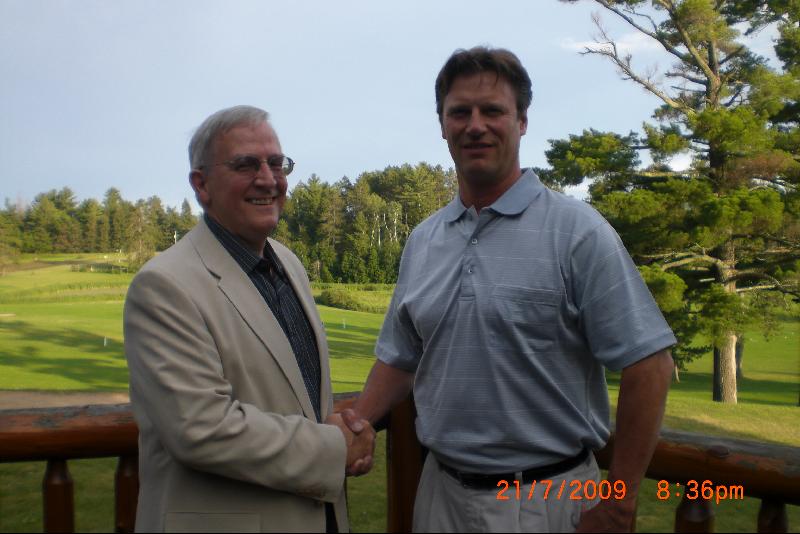
And here is Mike's award:
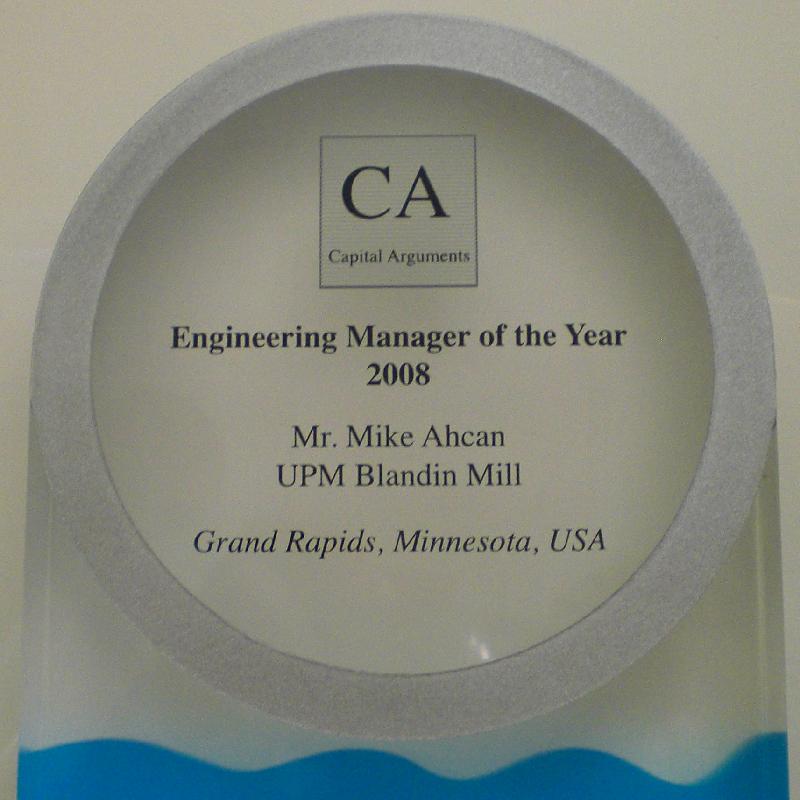
We normally accept nominations in the November-December time frame. They can be sent to jthompson@taii.com with "EMOY Nomination" in the subject line.
|
|
|
|
|
________
Please write when we tickle your brain cells! Email jthompson@taii.com
|
|
|
________

|
|
|
|
|
|
|